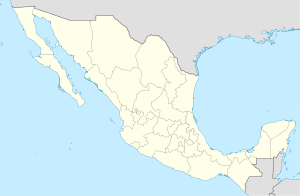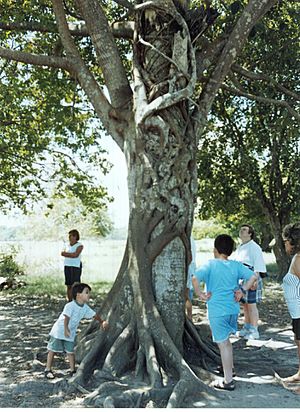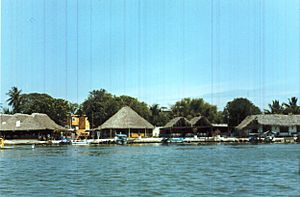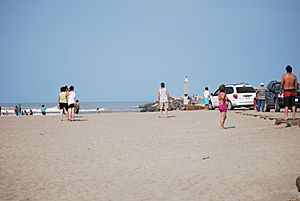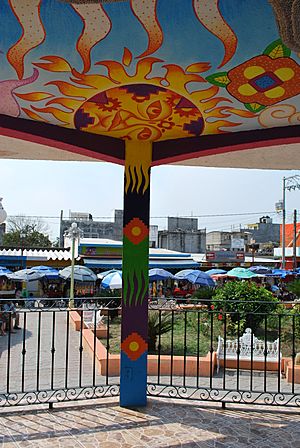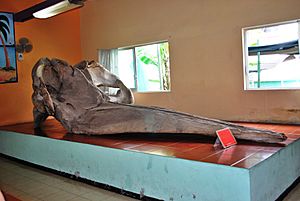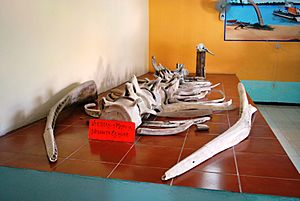Tecolutla facts for kids
Quick facts for kids
Tecolutla
|
|
|---|---|
|
Town and municipality
|
|
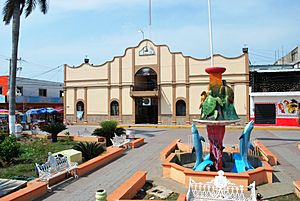
Fountain and municipal palace of Tecolutla
|
|
| Country | |
| State | Veracruz |
| Municipal Status | 1879 |
| Area | |
| • Municipality | 471.31 km2 (181.97 sq mi) |
| Elevation
(of seat)
|
10 m (30 ft) |
| Population
(2005) Municipality
|
|
| • Municipality | 24,258 |
| • Seat | 4,523 |
| Time zone | UTC-6 (Central (US Central)) |
| • Summer (DST) | UTC-5 (Central) |
| Postal code (of seat) |
93570
|
Tecolutla is a town and municipality in Mexico. It is located on the Tecolutla River along the eastern coast of Veracruz state. Tecolutla has the closest beaches to Mexico City. This makes it a popular spot for tourists, as it is only a four to five-hour drive from the capital.
The town is at the northern end of a special tourist area. This area is along the Gulf of Mexico and is called the "Emerald Coast." It stretches south all the way to the city of Veracruz. Tecolutla is famous for its beautiful natural areas. These include wetlands with estuaries, canals, and mangrove forests near the river. The name Tecolutla means "place of the tecolotes or owls."
Contents
Fun Things to Do in Tecolutla
Tourism is the most important and growing activity in Tecolutla. The town has about 15 kilometers of beaches facing the Gulf of Mexico. The entire municipality has 40 kilometers of coastline. These beaches usually have gentle waves and warm water.
Sometimes, strong cold winds called "nortes" blow in from the north. This happens between December and February. These winds can make the temperature drop quickly. This changing weather means Tecolutla is not as big a resort as places like Cancun.
Hotels and Places to Stay
The oldest hotel in Tecolutla is the Hotel Tecolutla. It was built in 1949 and still looks like it did back then. Many new hotels have opened since the year 2000. Most of them are for travelers from Mexico City who are looking for affordable places to stay. People from Xalapa, the state capital, also visit.
Tourism is busiest during holidays like Christmas and Easter. Special events, like the yearly fishing tournament, also bring many visitors. During the rest of the year, the town is much quieter.
Exploring the Beaches
The beaches in Tecolutla town are split into North and South beaches. Both have hotels, restaurants, and camping spots. You can also take boat rides and ride bicycles. At South Beach, there are special walls called breakwaters that protect the mouth of the Tecolutla River. You can also find beachside cabins there.
Docks offer boat trips up the river or fishing trips in the Gulf. A special type of boat called a panguita is often used. It looks like a very long canoe and is great for exploring the estuaries.
Local Attractions and Events
There are many interesting places to visit. You can see the Hueytepec archeological zone and the Parish of Nuestra Señora de Guadalupe church. There's also the old lighthouse, the Hotel Tecolutla, and the Municipal Palace.
The Marine Museum is a great place to learn about sea life. It's on Matamoros Street and has over 300 different kinds of water animals. Some are alive, and some are preserved.
Tecolutla also hosts fun events. From April to September, a beach called Vida Milenaria is set aside for sea turtles. These turtles come back to lay their eggs. A project led by Fernando Manzano, known as "Papá Tortuga" (Daddy Turtle), helps protect them. Volunteers collect the eggs and help between five and six thousand baby turtles hatch and get to the sea each year. Tourists can even help release the baby turtles!
Fishing and Festivals
The yearly fishing competition in May brings many visitors. People come from all over Mexico and even other countries. There are contests for catching shad, sea bass, and tarpon. These events happen both in the sea and on the Tecolutla River. This is one of the busiest times of the year for the town.
Another fun event is the Coconut Festival in February. Local restaurants and hotels work together to make "the world's largest coconut custard." In 2008, this huge dessert was 2.15 meters by two meters. It took about 6,000 coconuts and two tons of sugar! After it's shown off, everyone gets to have some for free.
Nearby Historical Sites
A notable place to visit nearby is the El Tajín archeological site. It was built by the Totonac people, who also lived in Tecolutla. Tecolutla is the closest beach to this site, which is about 40 kilometers away. El Tajín was a very important religious center. It still holds celebrations every year during the spring equinox.
Tecolutla's Natural Beauty
Tecolutla's natural setting and climate are its biggest attractions. It is located on the Veracruz coast and has many estuaries, canals, and mangroves. These estuaries are where the Tecolutla River meets the sea. The river flows through the states of Puebla and Veracruz. It is surrounded by mountains to the east and south.
The river gets its water from summer rains in lower areas and year-round rains in higher areas. It passes by many towns before reaching Tecolutla.
Exploring the Estuaries
These estuaries are full of plants and animals. You can find crabs, lobsters, red snapper, shad, and white and black herons. In the mangroves, there are two kinds of alligators.
Three estuaries are most popular to visit:
- Del Silencio: This one has about five kilometers of water you can travel by boat. It's full of mangroves. It's called "Del Silencio" (Of Silence) because it's so quiet, except for insects and water dripping from trees.
- De la Cruz: This estuary has very clear water. You can travel 25 kilometers by boat here. Sea bass can be caught during fishing season.
- Del Narajo: This is the largest estuary, with 40 kilometers of navigable water. It's bordered by ranches and orange groves.
You can also see many wild birds like ibis, cormorants, parrots, guinea fowl, eagles, falcons, and storks.
More Beaches to Discover
The municipality has 40 kilometers of beaches. North of Tecolutla, for about ten kilometers, are important beaches like Santa María del Mar and Barra Boca de Lima. These have warm waters with some waves. The Largartos Estuary is at Barra Boca de Lima.
A bit further (32 kilometers) is Barra Tenixtepec, which is great for water sports. Tecolutla is the start of a small tourist area that includes beaches like La Guadalupe, La Vigueta, Playa Oriente, Monte Gordo, Casitas, and Maracaibo. This area is known as the Costa Esmeralda (Emerald Coast) because the ocean near the beaches looks green. Many hotels, bungalows, and trailer parks are in this area.
Tecolutla's Past
Tecolutla began as a settlement long before the Spanish arrived. Different groups of people had ruled it over time. The Tecolutla River was first visited by Europeans in 1518 by Juan de Guijalva. This was three years before the Spanish Conquest of the Aztec Empire. The Spanish began settling here in 1522.
At first, there were fights between the Spanish and local people. But over time, their cultures, plants, animals, and ways of life mixed. Old religious sites were left behind and are now archeological zones.
Important Moments in History
In 1810, the Mexican War of Independence started. Serafin Olarte led local efforts. In 1813, the ports of Tecolutla and Nautla were taken by Mexican rebels. They used these ports to bring in weapons. In 1814, the royalist army drove the rebels out.
In 1824, the state of Veracruz was created. Tecolutla became a community under the Papantla area. In 1825, a commercial port was built. This port was later blocked by the French during the Pastry War in 1838.
In 1847, a U.S. ship anchored in Tecolutla. This was part of the start of the Mexican–American War. In 1857, sixty Italian families moved here. This was part of an agreement between the Mexican and Italian governments to encourage people to move to Mexico.
In 1866, Tecolutla was taken over by forces loyal to Maximilian. The municipality was officially created in 1879. The community of Tecolutla became a town in 1882.
Recent Challenges
In 1942, two ships were attacked in the port of Tecolutla. In October 1999, the Tecolutla River flooded badly. This caused a lot of damage to homes and businesses in the town. Most of this damage has been fixed, and many roads and bridges are now better than before.
Tecolutla faced another natural disaster on August 27, 2007. The center of Hurricane Dean hit the town. The strong winds and rain caused power outages and rivers to overflow. Many roads, banks, and gas stations closed. About 15,000 people had to go to shelters.
On August 21, 2021, Hurricane Grace hit Tecolutla. It was a very strong Category 3 storm with winds of 125 mph. This made it the strongest hurricane ever recorded in the Bay of Campeche.
The Tecolutla "Monster"
At the Marine Museum, you can see bones and photos of what people call the "Tecolutla Monster." These are actually parts from a few different sperm whales. The story of the "monster" comes from a whale that washed ashore in 1969. Its body was cut up, burned, and moved to Tecolutla's beach.
At first, some people thought it was a narwhal or another type of whale. Because the original body was lost, it's hard to know exactly what kind of whale it was. Whale strandings have happened before on Mexico's Atlantic coast. For example, a sperm whale washed up in Tecolutla in 1976.
People's descriptions of the dead creature were very different. Some thought it looked like a giant worm or had "wool" or armor. It was estimated to weigh between 24 and 35 tons and was about 22 meters long. There were even rumors that a science institute wanted to buy it, thinking it was prehistoric.
The whale body was found by locals on Palmar Susana beach. They kept it a secret at first. It took 14 hours to get the huge animal out of the water. People started cutting it apart on the beach, hoping to make money from its bones.
Eventually, the local mayor was told it was a crashed plane. A rescue team found the enormous head and part of the body buried. They decided to bring the body to Tecolutla town. A large truck was used to move it to the beach in front of the lighthouse. Many photos were taken.
News of the mysterious creature spread, and many people came to see it. Even though it was decomposing and smelled bad, the mayor kept it as a tourist attraction.
The Marine Museum reopened in 1997. Besides the "monster" bones, there are also paintings of it. Today, not many people in Tecolutla know about the monster. Most witnesses have moved or passed away. There are no local newspapers from that time, and city records are scarce. Only a few photographs remain.
About the Municipality
The municipality of Tecolutla is in the northern part of Veracruz state. This area is known as Totonacapan. Most of the municipality's borders are formed by the Tecolutla River and the Gulf of Mexico. The municipality has 375 communities and covers an area of 471.31 square kilometers. It is about ten meters above sea level.
It shares borders with the municipalities of Papantla, Martínez de la Torre, and Gutiérrez Zamora. The Gulf of Mexico is to its east. The climate is hot, with an average temperature of 23.6 °C. The area gets a normal amount of rainfall for Mexico. Fast-growing trees like guarumbo and mangroves grow well here.
Economy and People
Much of the municipality is rural. Farming and raising animals are the main ways people make a living. Important crops include corn, green chiles, beans, bananas, vanilla, sugar cane, tobacco, pineapple, and citrus fruits like oranges and grapefruits. Coconuts are also grown. Farmers raise dairy and beef cattle, pigs, sheep, fowl, and bees.
Fishing is also important. Fishermen work together to catch common bass, crabs, shrimp, oysters, shad, and sea bass. Vanilla beans are a special local crop. They have been grown here since ancient times. Vanilla was even sent to the Aztecs as a tribute. The harvest time is in November and December. You can see the beans drying in the sun.
The developed areas, mainly Tecolutla town, also rely on tourism. This includes hotels, lodges, and restaurants.
The municipality has a population of 24,258 people. Only 4,523 live in the town itself. The Totonac people still have a strong presence here. About 6% of the population speaks the Totonac language. You can often spot them by their special clothing. Men wear white, wide-leg trousers and a loose white shirt. Women wear embroidered blouses and lacy white skirts. They also wear a colorful half-apron over their skirt and a bright scarf.
Images for kids
See also
 In Spanish: Tecolutla para niños
In Spanish: Tecolutla para niños


